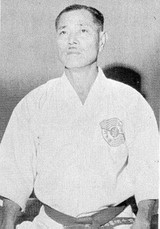“The Grandson of Matsumura Soken”

Tsuyoshi Chitose 1898 – 1984
“The Grandson of Matsumura Soken”

Tsuyoshi Chitose was born on October 18, 1898 in the town of Kumochi, Naha City, Okinawa Prefecture. He came from a martial arts lineage—his maternal grandfather was Matsumura Sōkon.
While in Okinawa, Chitose grew up studying the art of karate, as well as kobudō. At the age of seven, he was introduced into the secrets of Naha Te by the respected fifth master Mr Aragaki Ou. His teachers included Aragaki Seisho, Higashionna Kanryo, Chotoku Motobu, Chotoku Kyan, and Hanashiro Chomo.
In 1921, he moved to mainland Japan to study medicine.Chitose developed Chitō-ryū using his understanding of physiology to adjust traditional techniques making them more effective and less injurious to the bodies of long-term practitioners.
Chitose created Chitō-ryū by combining the strength techniques from Shuri-te, Shōrin-ryū and Shōrei-ryū, with those of Naha-te. While present, the influence of Tomari-te is less than that of the two previously mentioned foundation styles. Chitose also actively studied and taught Kobudo.
In 1922, Chitose assisted in the opening of Mr Funakoshi’s Shoto-Kai Yotsuya dojo. He instructed in kumite and the kata of Seisan and Bassai.
In 1946, O’Sensei opened a karate dojo in Naka Machi, Kumamoto. In 1975, he moved his dojo known as the SOHONBU to Tsuboi,Kumamoto City.
Chitose devoted his entire life to the preservation and perpetuation of Okinawan Kata. He is the author of “Kempo Karate Do–The Universal Arts of Self Defence”, published in 1957
In December 1961, he visited Hawaii, and stayed for several months. It was his first visit to the West. While there he taught, and made several public appearances, including a major demonstration, and classes at public schools. The visit was warmly supported by the Okinawan community. He then travelled to Canada at the invitation of Masami Tsuoroka, his former student, and Chief Representative of Chito-ryu karate in Canada. During his visit, Dr Chitose conducted demonstrations, held a clinic, and presided over the Canadian National Karate Association tournament.
In 1958, O’Sensei attained the rank of Ju Dan from Zen Okinawa Karate Kobudo Rengo Kai (The All Okinawan Karate & Weaponry Association). He later became Supreme Instructor, 10th Dan of Chito Kai Karate.
Chitose died in 1984 at the age of 86. He will be remembered for his dedication to Chito-Ryu, and Okinawan Karate, and to the education and involvement of the public in the martial arts.
We who study Karate-Do
Should never forget the spirit of the warrior’s way,
Through Peace, Perseverance and Hard Work
We will not fail to reach our goal.
…….. Tsuyoshi Chitose
